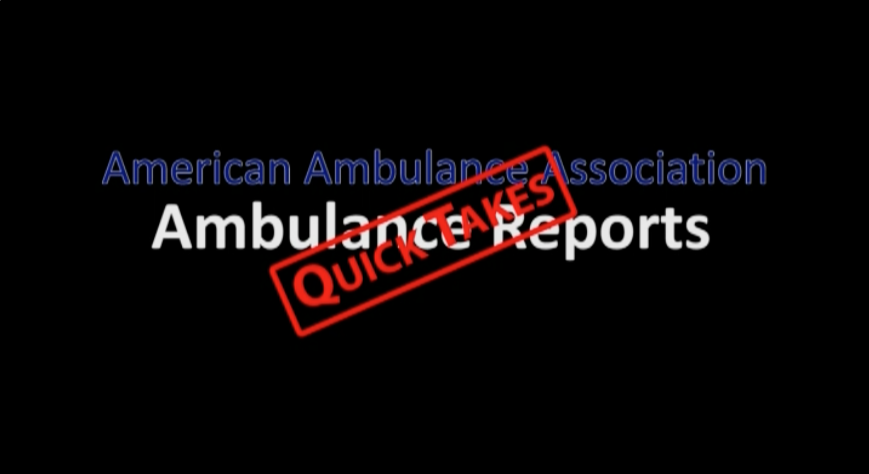Collecting Data for the Future: Understanding the New Statutory Cost Collection Requirement
By Kathy Lester, JD, MPH, Lester Health Law PLLC
On February 9, the President signed into law the Bipartisan Budget Act of 2018 which thankfully included a five-year extension of the ambulance add-ons. Along with the add-ons extension, the Congress included language requiring the Centers for Medicare and Medicaid Services (CMS) to develop and implement a new cost data collection system for ambulance service providers and suppliers. While cost collection may sound difficult, the process outlined in the new authority strikes the appropriate balance and will minimize the burden on ambulance service providers and suppliers, while allowing the federal government to collect meaningful data that can be used to address the inadequate reimbursement rates and modernize Medicare ambulance payment policies.
Knowing some time ago that the industry would need to provide CMS with cost information, the AAA for the past six years has been working with The Moran Company, a well-respected health care analytical firm in DC, on the best way to collect ambulance cost data. Most recently, the AAA Payment Reform Committee has been working with the cost collection experts at The Moran Company to identify the data elements that CMS would need to collect to establish accurate information about the cost of providing ground ambulance services. We have also developed educational materials that we will share with Members to help ensure a smooth transition into this system.
General
The core components of the new cost collection system for providers and suppliers of ground ambulance services are:
- A requirement that the Secretary of Health and Human Services, through notice-and-comment rulemaking, must develop a data collection system to collect: (1) cost; (2) revenue; (3) utilization; and (4) other information determined appropriate by the Secretary;
- This system may use a cost survey; and
- The data collect should include information: (1) needed to evaluate the extent to which costs are related to payment rates; (2) on the utilization of capital equipment and ambulance capacity; and (3) on different types of ground ambulance services furnished in different geographic locations and low population density areas.
Representative Sample
Under the statute, the Secretary must select a representative sample of providers and suppliers from whom to collect data. The sample will be determined based on the type of providers and suppliers (such as those that are part of a governmental organization, fire, hospital-based, etc) and the geographic locations (such as urban, rural, and low-population density areas). An individual provider or supplier (defined most likely by National Provider Identifier) may not be requested to submit data in two consecutive years, to the extent practicable.
Reporting Requirements
A provider or supplier selected to report data must do so in the form and manner and at the time specified by the Secretary. If a provider or supplier that has been selected to report does not do so, then the provider or supplier may be subject to a 10 percent payment reduction, unless the hardship exemption applies. Providers or suppliers that are penalized may seek a review of the application of the penalty. The Secretary does have the authority to take into consideration certain hardships as to why a provider or supplier was unable to submit their data and waive the penalty.
Modification Over Time
The Secretary may revise the system over time.
Public Availability of the Data
The Secretary will provide the information collected available through the CMS Website, similar to the process used for other data CMS collects.
MedPAC Report
In addition, the language includes a study/studies from the Medicare Payment Advisory Commission (MedPAC). MedPAC is required to issue at least one report, and potential subsequent reports, on the following:
- An analysis of the information submitted by providers and suppliers through the data collection system;
- An analysis of any burden on providers and suppliers associated with the data collection system;
- A recommendation as to whether information should continue to be submitted through such data collection system or if it should be revised;
- The adequacy of payments for ground ambulance services;
- Geographic variations in the cost of furnishing ground ambulance services; and
- Other information determined appropriate by the Commission.
Timeline
The Secretary must implement the data collection system according to the following timeline:
The AAA will continue to keep you informed as the development and implementation of the ambulance cost data collection system moves forward.
| 12/31/2019 |
- Specify the data collection system
- Identify providers and suppliers that would be required to submit information for the representative sample
|
|
2020 – 2024
|
- Collect data each year from a representative sample of providers and suppliers
|
| 2022 |
- First year a provider or supplier that has been asked to submit data and has not sufficiently submitted the data may be subject to a 10 percent payment reduction.
|
| 2023 |
|
| 2025+ |
- Collect data as the Secretary determines appropriate but no less often than once every 3 years
|
The AAA will continue to work with The Moran Company and other experts to make sure data collection system works for all ambulance service providers and suppliers and leads to information that the industry needs to move toward making the add-ons permanent and modernizing the benefit to include new payment models, including transports to alternative destinations, treatment with referral and no transport, and mobile integrated health.









